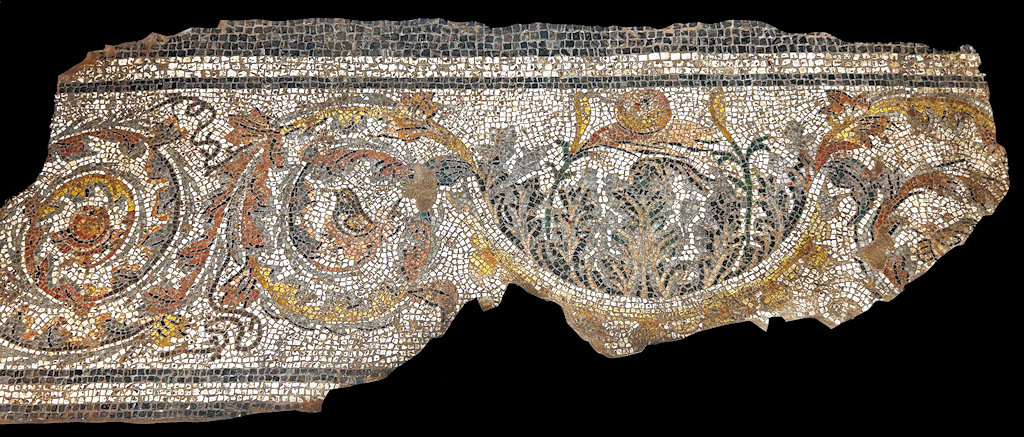In Montreux, at the intersection of the Chemin de Baugy and the Chemin de la Minjarde, about one kilometer to the north of the Lac Léman, a villa was partially excavated on several occasions: in 1802, 1877, 1905-1906, 1987 and 1990 (in the literature the locality is referred to as B(e)augy and Le Châtelard). On sloping terrain rooms and courtyards of the main building were found, and next to the main building baths with heated rooms. Ceramics and the painted decoration suggest that the villa was built in the first half of the second century. It was in use until the late fourth century.
Plan of the villa. Fuchs 1993, fig. 1.
In black: excavated remains. In grey: rooms with hypocausts of the baths. A: upper terrace; B: rooms; C: upper court; C': lower court;
D: rooms; D': mosaics discovered in the 19th century; E: east wing; F: baths; G: porticus; H: drains; star: paintings discovered in 1905-1906.In his description of Baugy from 1824 Louis Levade noted that "an ancient manuscript claims that there was once a beautiful country house, with a considerable town from the time of the Romans, and says that at different times were unearthed marble columns, mosaic floors, works of carved alabaster, lead pipes, which served as a conduit for the water necessary for public or private baths. It is especially surprising how many coins were found in the excavations of this village. A foreigner came to buy them for several years from the inhabitants, and resold them at a considerable profit in the various cabinets of Europe. A mason, while demolishing an old wall, found a box whose contents of gold and silver coins made his fortune. A resident, while digging a site for a press, found, a few years ago, around thirty coins of the finest preservation, which he took to a founder to make shoe buckles".
A geometric mosaic discovered in 1802 is largely black-and-white, but has a few yellow and blue vegetative motifs (3 x 3 m.; apparently lost). In 1877 parts were found of the border of a mosaic of exceptional quality. Many tesserae are of marble and glass. Amongst vegetative motifs a bird can be seen. The mosaic was made around 200 AD.
Polychrome mosaic discovered in 1802. Levade 1824, Pl. 22.


Polychrome mosaic discovered in 1877. Photos: Von Gonzenbach 1961, Taf. 41 and Musée de Montreux.Levade also mentions "rooms covered all around with stucco with ornaments whose colors were still very lively". Fragments of paintings were found in the baths in 1906.
Reconstruction of paintings found in the baths in 1906. Photo: Fuchs 1993, fig. 12.In 1910 a bronze applique from Baugy was published by Waldemar Deonna. Two heraldic sea horses hold a bearded head in their mouth, of Oceanus or a similar deity. Two Nereids lie on the back of the horses, leaning against a dolphin above a shell.
Bronze applique from Baugy. W. 0.17, h. 0.07. Photo: JbSGU 1910, fig. 64.
Literature
Von Haller 1812, 300-301; Levade 1824, 38-39; Rode 1877; Jahresbericht der Schweizerischen Gesellschaft für Urgeschichte 3 (1910), 127; Deonna 1910, 9-10; Drack 1950, 58; Von Gonzenbach 1961, 89-91; Drack-Fellmann 1988, 445; Morel 1988; Jahrbuch der Schweizerischen Gesellschaft für Ur- und Frühgeschichte 74 (1991), 267; Fuchs 1993.
[7-Mar-2024]